More about: 10 Things to Do in Kyoto in Winter
Kyoto is characterised by a very cold, rainy and even snowy winter. However, these weather changes are not an impediment for you to make the most of the great cultural and recreational offerings that are usually available during these months. From festivals to hot springs to extreme sports, there are plenty of things to do in the city.
For example, among the best things to do in Kyoto during the cold months, you can see a different perspective of the town of Arashiyama, which is lit up with hundreds of lanterns in winter. You can also chase away the spirits with soybeans in the Gion Quarter, take amazing photographs at temples and shrines, take advantage of the nostalgic scene of the season, among other activities I'll tell you about in a moment.
1. Eat some nabe and enjoy the most popular winter food in Kyoto

Walking through the streets of Kyoto in winter and seeing groups of people sharing nabe, also known as hot pot, is a common sight for locals. Go to a local traditional restaurant or the Nishiki Market and try this popular seasonal dish.
This meal should be prepared by yourself at the table with the people who accompany you. One of them will be in charge of cooking and adding the ingredients to the pot: mushrooms, tofu, cabbage, meat, green onions, according to the taste of the guests. Afterwards, everyone serves the stew in their own bowl, accompanied by rice.
But if, as well as trying nabe, you want to explore Japanese culinary culture, then you might consider taking a food tour of Kyoto. You could also join one of the best cooking lessons in Kyoto to learn how to make other sweet and savoury dishes.
2. Participate in a tea ceremony in Kyoto and enjoy the warmth of this ancient drink

Participating in a tea ceremony during your 2-day stay in Kyoto or longer is a popular activity in winter. You can be in an air-conditioned space and enjoy the warmth of a matcha (green tea) drink. All this while learning about this ancient art form .
You will be guided by a geisha (hostess). She will teach you the sado, or way of tea, which consists of tranquility, respect, harmony and purity, with the purpose of appreciating the beauty of the simple things in life, as dictated by the philosophy of wabi sabi.
During the Kyoto tea ceremony experience you will have the option of wearing a kimono. You will watch in front of you the preparation of matcha tea, which incorporates a series of rituals, bows and gestures by the hostess. Afterwards, you will taste the beverage and a kyogashi, a handmade sweet used in ceremonies.
3. Take a photo tour of Kyoto in winter and get a different perspective of the city
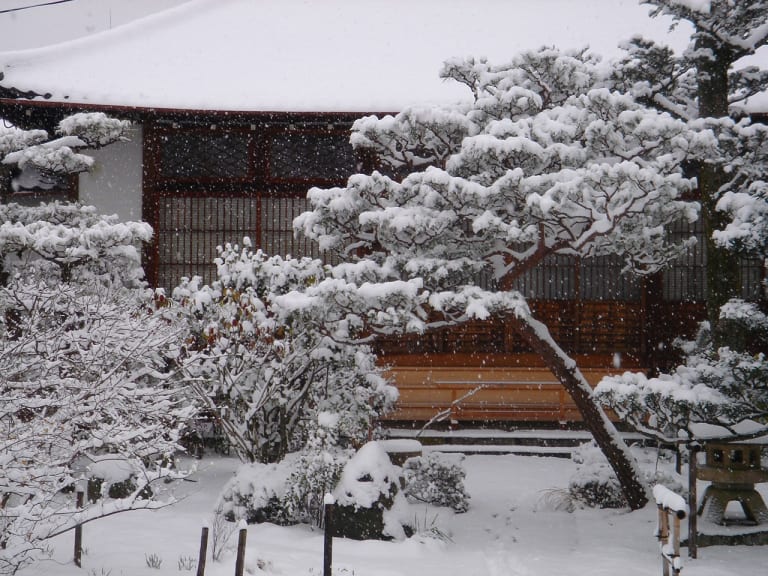
A good idea during the winter is to grab your camera and take a tour of the city of Kyoto. You will get a different perspective of the streets and historic buildings, thanks to the nostalgic atmosphere of the season.
You can visit Kinkaku-ji or Golden Pavilion, Ginkaku-ji Temple among other local shrines and temples. You will see how these shrines change their appearance, especially during the month of February in Kyoto, which is the snowiest period.
This is an activity you can do on your own or join a private tour in Kyoto. Either way, you will get magical scenery: frozen ponds, surrounded by snow-covered gardens, as well as the roofs of their respective temples, shrines and pagodas. All this under a cloudy sky, which provides you with soft natural light and a series of shadows that you can take advantage of for wonderful photographs.
4. Take part in the Arashiyama Hanatoro or Festival of Lights in Kyoto

The annual Arashiyama Hanatoro Winter Festival is held in the city of Kyoto in December. For 10 days, you can enjoy a dreamlike atmosphere in this town, where the streets and lanes are lined with flowers and traditional lanterns.
To enjoy this spectacle, you should go to Arashiyama, about 30 minutes by car from the centre of Kyoto. There, after sunset, you will see the lighting of more than 2,500 lanterns placed on the ground along a route of about 5 kilometres.
You will see a different perspective of the Togetsukyo Bridge across the Katsura River, illuminated by pale blue lanterns. The Arashiyama Bamboo Forest area, meanwhile, will amaze you with its night scene: shadows and glows produced by the lights passing through the hundreds of moso bamboo stalks on this trail.
In fact, you can upgrade this experience and embark on a food tour of the Kyoto Arashiyama and Sagano Bamboo Forest. You will enjoy the lights while sampling some seasonal sweet and savoury dishes at the food stalls in this natural area.
5. Take advantage of the cold temperatures of the winter season in Kyoto and relax in an onsen

During your stay of at least 3 days in Kyoto, you can visit an onsen or hot spring to relax. Take advantage of the cold temperatures in the winter season and enjoy the hot water in these pools.
This is a popular attraction for locals and tourists alike. You will find onsen in the city centre and others in a few nearby districts within easy reach. In any of them, you will have the opportunity to enjoy both indoor and outdoor bathing, allowing you to be in touch with nature. It all depends on your preferences.
For example, some onsen you could visit are the following:
- Kurama Eleven, with open-air sulphur waters and a breathtaking mountain view. It is located on Kurama Mountain, about 26 minutes drive from the centre of Kyoto.
- Funaoka Onsen, located about 11 minutes from the centre by car and 30 minutes by public transport. This hot spring dates back to 1923 and is considered a tangible cultural property.
- Goko-yu Onsen, this is an onsen-style public bath, which you can visit about 15 minutes by public transport from the city centre.
6. Enjoy the Ume Matsuri or Plum Tree Festival in Kyoto and watch the plum trees in bloom
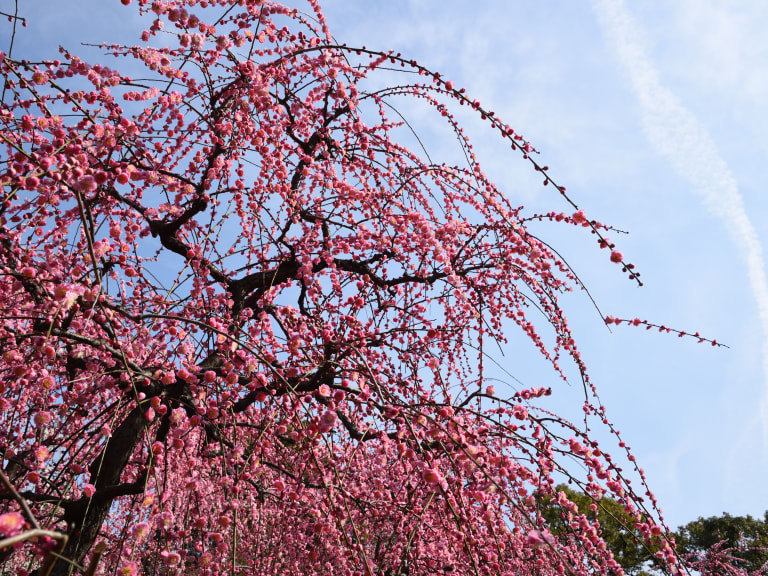
Among the things to see and do in Kyoto in winter is the Ume Matsuri or Plum Blossom Festival. Every year, locals and tourists flock to some temples during January and February to enjoy this natural spectacle. Be part of this celebration and see the plum trees in bloom.
You can visit the Kitano Tenmangu Shinto Shrine, which is home to approximately 2,000 plum trees. Also, at the Buddhist Kaju-ji Temple, whose history dates back more than 1,000 years and is considered one of the finest temples in Kyoto, you will have the opportunity to see the ancestral plum tree, transplanted from the Imperial Palace.
During this experience, you will see the vibrant colours (pink and white) of the plum blossoms, which blend in with the nostalgic atmosphere of the winter season. You will also enjoy the sweet scent of the blossom.
7. Watch the throwing of soybeans at evil spirits at Yasaka Shrine in Kyoto

Warding off evil spirits by throwing mame (soybeans) at them is a traditional activity in Kyoto. You can observe this ritual, which dates back to the Muromachi period (mid-14th century), during the first days of February in the Gion Quarter.
Setsubun (separation of seasons), as this ancient celebration is known, is held at Yasaka Shrine. There, geishas and maiko chase away the spirits, represented by people in traditional warrior costumes and devil masks.
Along with the throwing of the mame, you will hear the phrase "oni wa soto! fuku wa uchi!", which translates as "Out with the demons! let good luck come in! All this takes place in a lively and picturesque atmosphere.
Afterwards, the ritual continues by eating some seeds. This will make your life long. In fact, it is said that the more mame you eat, the longer your longevity line will be. Likewise, locals usually eat maki sushi on this day to attract fortune.
8. Go to a ski resort in Kyoto and enjoy this winter sport
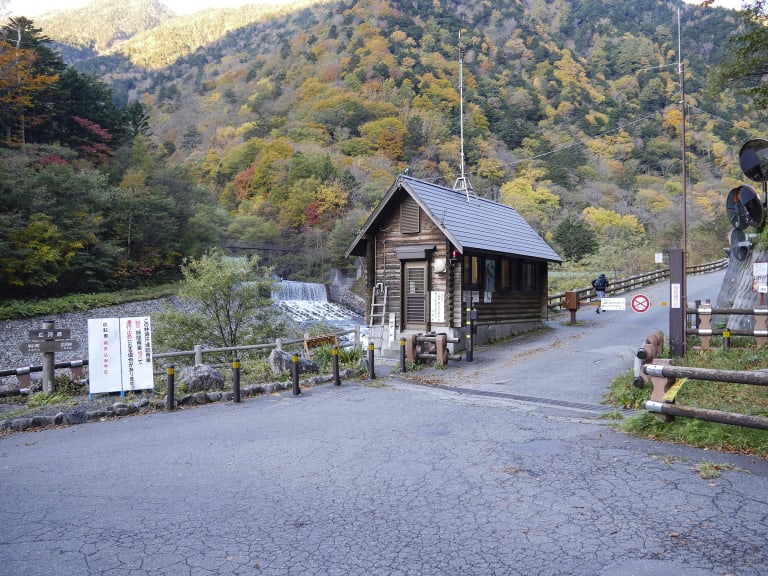
Kyoto is surrounded by mountains and many of them are usually covered with snow in December, January and February. If you are a winter sports enthusiast and happen to be in the city during this season, you should take advantage of the weather to go skiing or snowboarding.
Some of the popular ski resorts in Kyoto are as follows:
- Hirogawara Resort. On the outskirts of Kyoto you will find this mountain with a maximum height of 635 metres, which is suitable for amateur skiers.
- Swiss Ski Village in Ine, Kyoto Prefecture. This approximately 683-metre-high mountain is ideal for snowboarders and beginners.
- Oeyama Ski Resort, a 480-metre-high mountain in Miyazu, Kyoto Prefecture.
9. Join the Hatsumode tradition in Kyoto and welcome the new year
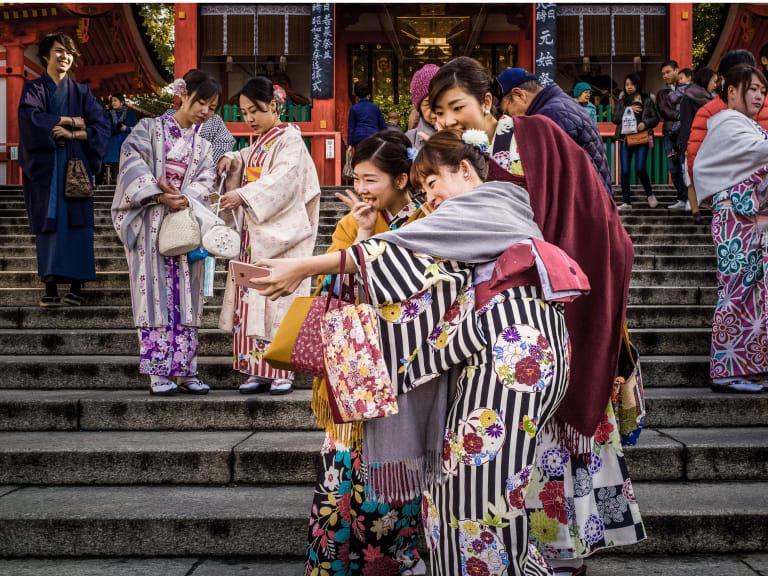
Welcoming the new year is one of the biggest celebrations in Kyoto and Japan. Join this tradition called Hatsumode or first temple visit and experience something different: rituals, seasonal foods, colourful performances, and more.
You can go to one of the city's temples on New Year's Eve on December 31st to participate in the Joya no Kane (bell ringing ceremony). This will eliminate bad karma and start the year with good luck. At Chion-in Temple, you will see 17 monks ringing the legendary bell, considered to be the largest in Kyoto.
During the first week of January, you will also have the opportunity to enjoy the atmosphere of celebration at the various Buddhist and Shinto temples. For example, Heian Jingu Temple, Kitano Tenmangu Temple, among others. There, pick up an omikuji, which is a strip of paper with writing on it, and find out your fortune for the year ahead.
10. Attend the Musha Jinji in Kyoto: the military archery ritual to dispel bad luck
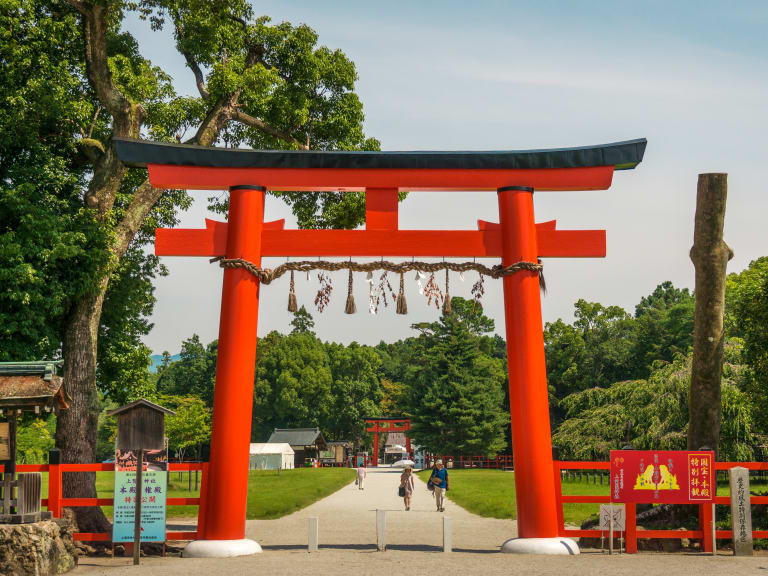
Kyoto is full of amazing celebrations, one of them being the Musha Jinji. This is a military archery ritual, held annually during mid-January, for the purpose of dispelling bad luck. Attend this spectacle that keeps alive the legacy of the last period of Japan's classical era, the Heian.
This activity takes place at Kamigamo Shrine. You should arrive before 11:00 am to get a good spot to enjoy this :::link|text=cultural spectacle of Kyoto|element=sc-182-1390:::.
During the ceremony, you will witness the firing of whistling and purifying arrows. All of them are shot at objects identified with the word oni, which means demon. The more than 2,000 archers are dressed in kariginu, the costumes of the Heian court.
Temperatures in Kyoto in winter

The average temperature in Ky oto during the winter months, which runs from mid-December to mid-March, is usually between 7ºC and 5ºC. Rarely will you see the thermometer drop to around -3ºC or rise to 9ºC. Basically, winter in Kyoto is mild compared to regions such as Hokkaidō, where daily temperatures are 0°C.
Throughout your stay in Kyoto during the winter period, you will experience dry and cold weather. You will also notice partly cloudy skies and shorter days. These months often see periods of rain, blizzards, snowfall and night frosts.
Tips for keeping out the cold in Kyoto in winter

If your trip to Kyoto coincides with winter, you should be aware that the city's weather during this season is cold, with some rainy days and some snowy days. Therefore, you should take precautions regarding your clothing and food, so that you don't have any inconveniences.
Some tips to consider include the following:
- Dress in layers, so you can adapt to temperature changes during the day. Keep in mind that although it may be cold outside, shops, trains and buses are heated, so you can remove some clothing if necessary.
- Take a bottle of warm water with you so you don't get cold and stay hydrated.
- Eat warm meals such as nabe or ramen, especially in the evenings when temperatures tend to drop the most. This will help keep your body warm.
- Don't forget your mackintosh or umbrella, as rainfall is often unexpected.
The tourist crowds in Kyoto in winter
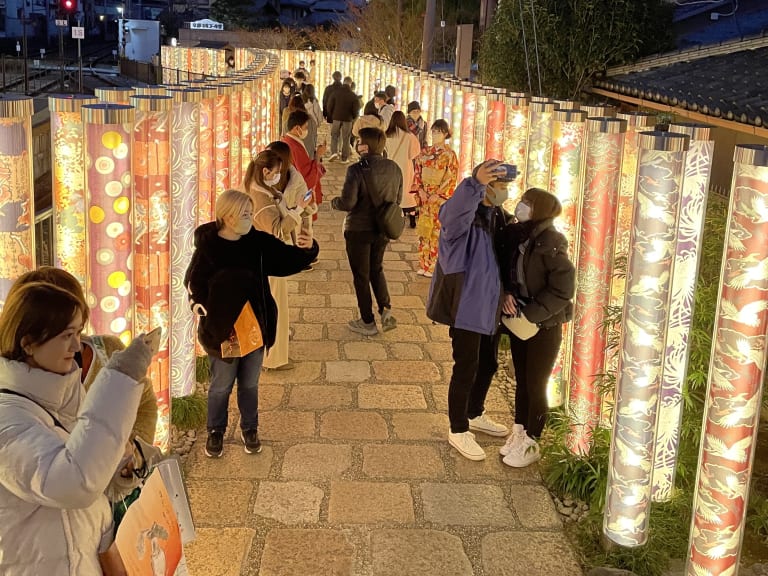
December is a time of transition between autumn and winter, so it is normal to get a high number of visitors in the second half of December, as temperatures still remain between 7°C and 9°C. However, during January and February, the picture changes significantly. Tourist demand decreases and a low volume of people is recorded.
Generally speaking, the number of tourists in Kyoto during winter is generally low compared to other times of the year. However, the city has a wide range of cultural and leisure activities during the cold months which, together with low airfares and accommodation prices, are attractive to visitors.




